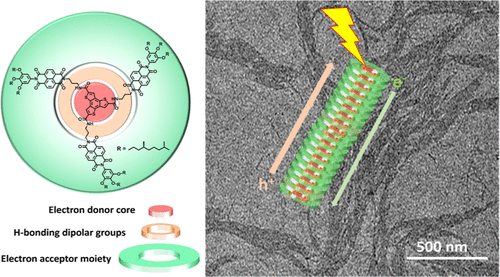Long-Lived Charge Carrier Photogeneration in a Cooperative Supramolecular Double-Cable Polymer
A newly designed C3-symmetric disc-shaped chromophore, BTT(NDI)3 , features electron accepting naphthalene diimides linked to an electron donor BTT core. BTT(NDI)3 self-assembles in apolar solvents into highly ordered, chiral supramolecular fibers through pi-pi and 3-fold hydrogen-bonding interactions. This leads to a cooperative formation of plane-to-plane stacking of BTTs and J-aggregation of the outer NDIs. Such a structure ensures high charge mobility. Only photoexcitation of BTT in the BTT(NDI)3 polymers triggers a unidirectional electron transfer from BTT to NDI and results in (BTT center dot+-NDI center dot-) lifetimes that are by up to 3 orders of magnitude longer compared to (NDI center dot+-NDI center dot-) that is formed upon NDI photoexcitation. A multiphasic decay implies ambipolar pathways for charge carriers, that is, electron and hole delocalization along the respective BTT and NDI stacks. Our supramolecular approach offers potential for developing functional supramolecular polymers with continuous pathways for electrons and holes and, in turn, minimizing charge recombination losses in organic photovoltaic devices.

Joseph, J.; Berrocal, J. A.; Casellas, N. M.; Guldi, D. M.; Torres, T.; Garcia-Iglesias, M.
J. Am. Chem. Soc. 2024,
DOI:
10.1021/jacs.4c09637

Let's create a brighter future
Join our team to work with renowned researchers, tackle groundbreaking
projects and contribute to meaningful scientific advancements



















